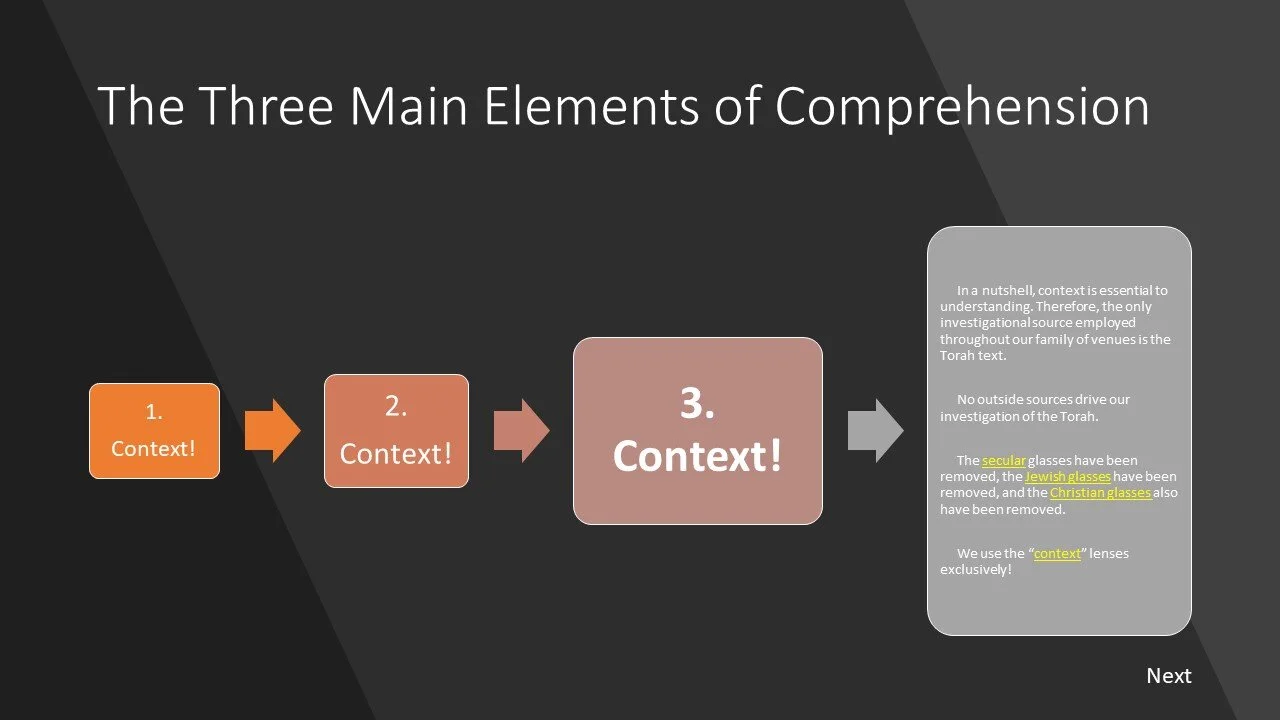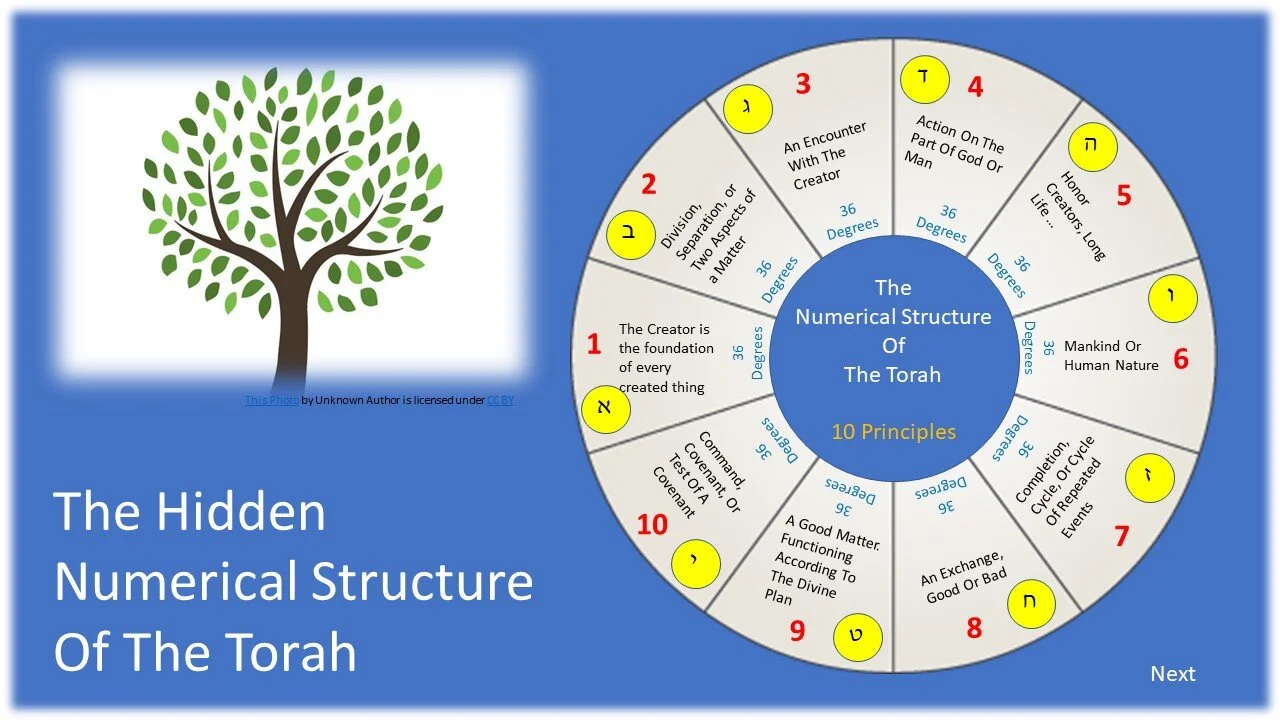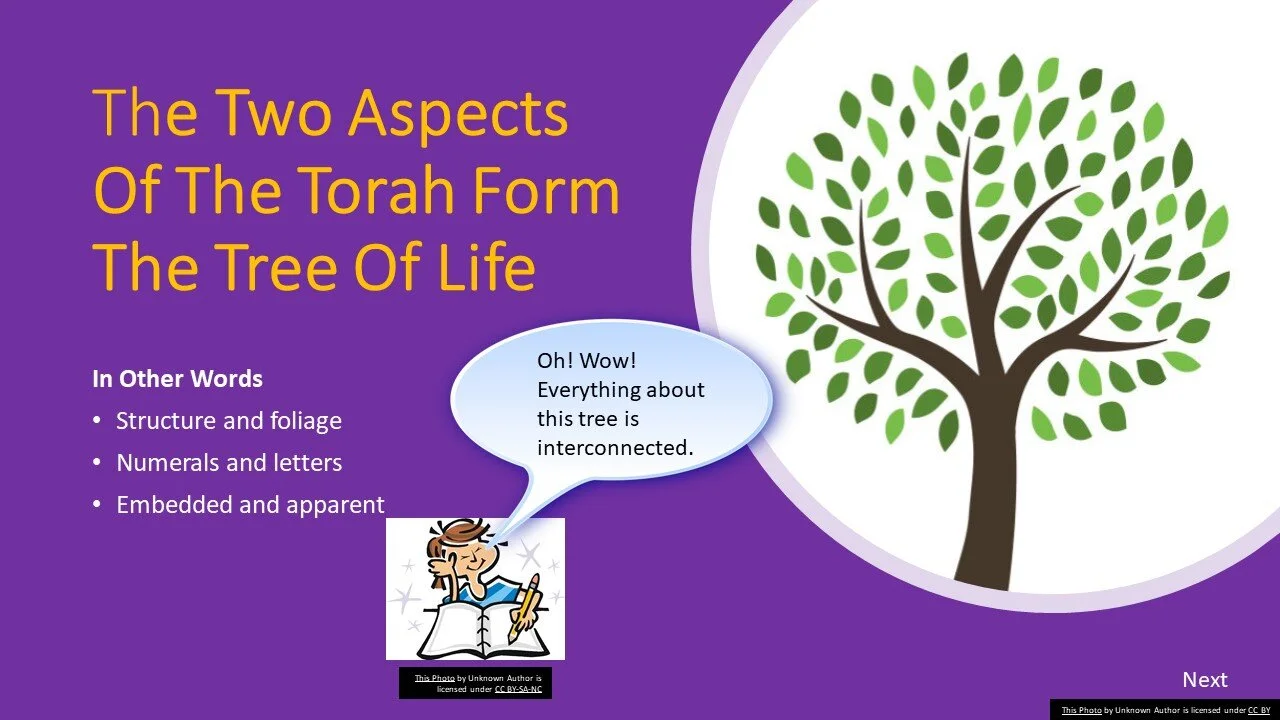03 Website Introduction
Understanding The Big Picture By Examining The Details
Introduction:
This website is a detailed discussion of the numerical structure embedded in the Torah; it is presented utilizing both "explanation" and a hands-on "demonstration." In the writer's opinion, such an exegetical strategy is necessary to thoroughly investigate a more complex passage of the Torah from The Creator's perspective. This study is not intended to be exhaustive, but its goal is to completely immerse the reader into the extensive nature of the numerical connections which are profusely embedded within the Torah text. Many things shall be repeated over and over again; this repetition is merely a reflection of The Creator's use of patterned repetition to perfect man's understanding of his divine teachings.
The sheer volume of the multitude of numerical connections that are involved in this study may be overwhelming to some readers, and it is with that obstacle in mind that the numerous text boxes, sectional headings, highlighting, and other graphic manipulations have been incorporated into this article to enable the reader to both simultaneously "skim" and "engage" with the text. These textual manipulations also enable the reader to quickly "revisit" a discussion again for clarification or review.
A Matter Of Context And Perspective
The purpose of this extensive exercise is to understand the language and meaning of the Hebrew consonants, words, and verses, as found in the Chumash (the first five books of the Hebrew Bible which are codified in a book format) from God's perspective. It is a "given," from this writer's perspective, that God is the author of the Torah, and that Moses was the initial scribe of the Torah.
Understanding The Source From Other Sources
Again, the purpose of this extensive exercise is to understand the language of the Torah to demonstrate one's respect towards The Creator. The Torah is written for man's benefit; therefore, any criticism should be aimed towards man's opinions rather than the dubious authorship of the Torah.
The Creator chose to have this Torah delivered, both then at Sinai, and now, utilizing both oral, and written formats. Oral language is the progenitor of written language. Dictionaries and lexicons are products of the oral language; they do not predate it. Thus, the vocalization of the Hebrew language is the "primal" element of the language, and any form of script is a secondary feature. No matter what form of Hebrew script is studied, the primal foundation of the Hebrew language is the vocalization of the consonants and vowels. They have been "orally" transmitted, throughout all the generations of man; from Adam to Noach, from Noach to Shem (the father of the Eberites, Ber. 10:21), from Shem to Eber, from Eber to Abraham (the Eberite, Ber. 14:13), from Abraham to the children of Israel, from the children of Israel to the rabbis, and from the rabbis to us. When the paleo and the Babylonian scripts are studied, they cannot directly provide any information concerning the "vocalization" of the consonants and vowels. The ancient paleo Hebrew letter graphics, the current block Hebrew letter graphics, the modern cursive Hebrew letter graphics, as well as any other Hebrew letter graphic are mere, graphic "fonts." They are only contemporary navigational markers that guide the reader/listener through the text, and without the corresponding vocal sounds, they are meaningless. What they do represent is man's input, for by the hand of man is the language is inscribed in other documents and cultures. Using outside documents and other cultures to interpret the Torah text is tantamount to abandoning the Torah's context.
Use the “Context” Lenses Exclusively!
Commence fashioning your understanding of the Bible upon the Creator’s perspective rather than man’s.
Aside from the proper vocalization of the sounds, the second most crucial aspect of the Hebrew language and the Torah text is CONTEXT! CONTEXT! CONTEXT! It is impossible in both ancient Hebrew, and modern Hebrew to understand what is being communicated if one ignores the context. One of the foundational principles of "misinformation" is to take something out of context. Taking something out of "context" is one of the first subtle steps taken to "malign" the Torah, and The Creator.
In the realm of academic research, generally, the closer the scholar gets to the "primary" source, the more accepted and respected his research should be received. The quality of scholarship should be related to its "intimacy" with the original source. In this case, the work presented herein investigates and correlates the Hebrew language as it was spoken by The Creator. The Mosaic graphics were reviewed by the Creator, which can be deduced utilizing The Creator's acceptance of the script, which Moses the scribe inscribed. Moses wrote in Hebrew, rather than the Egyptian language that he would have been quite familiar with having been raised in the court of Pharaoh. The Torah is the divine and primary source of the Hebrew language. The baggage of additional source materials does not necessarily enhance one's understanding of the divine "usage" and "intention" of the Hebrew language; in fact, it might seriously "impede" the divine intention.
Generally speaking, modern scholars do not consider the Hebrew language to be the "primal" language of creation. Denying the Hebrew language as the "primal" source of all language and the Torah text is an intellectually polite "pooh pooh" smeared upon the divine authorship of the Torah; it is often disguised in the condescending cover term of "inspiration." There is a world of difference between "divine authorship" and "inspiration." Inspiration attempts to naturalize concepts and events in terms of modern science and natural occurrences. If the authorship of the Torah is divine than man's responsibility level may have to rise to an uncomfortable height, whereas if it is only inspired, the bar is lowered to almost a passive level of responsibility.
What is generally overlooked, when the Torah becomes a matter of "inspiration," is that the perpetrator and his audience are approaching the violation of the most severe of all instructions. They are embarking on the transgression of the "third commandment" concerning taking the name of The Creator in "vain"; meaning the "emptying" of the value of the words of The Creator. According to the numerical structure found embedded in the Torah, one encounters The Creator at the "three" or "third" or something. The "third commandment" is where every man makes his decision, either for or against The Creator. Are the words of the Torah his exact words, or are they the thoughts of God inspiring multiple authors over centuries to compile an "inspired" composition? Man, therefore, determines his level of respect concerning The Creator's instructions (The Torah) either to his benefit or to his demise.
When the author's context is "abandoned" and "replaced" with manmade sources, the foundation of "replacement" theology commences — replacing the truth of The Creator with the doctrines of men. This entire presentation of the numerical structure of the Hebrew alphabet is dedicated to CONTEXT! CONTEXT! CONTEXT!
Israel The Guardian Of The Text
Thankfully, to the credit of the Israelite/Jewish scribal tradition, a precisely accurate copy of these words is preserved for the contemporary reader. This, of course, is not the generally accepted view among most secular and religious scholars today. However, if the research below is embraced with a positive attitude toward the significance of the numerous repetitions of the set numerical pattern found embedded throughout the Chumash text; it might prove difficult for some to maintain a "vain" attitude toward the divine nature of the text.
A Personal Reminder For Both The Writer And The Reader
Remember Abraham may have strayed from the path through ignorance, but not through rebellious unbelief. Because of his "emunah" (faithfulness) and the "emunah" of his descendants we have in our hands today the "Torah," "The Tree of Life" to nourish and satisfy our souls. Blessed Be His Name Forever! Blessed are those faithful witnesses of precious memory!
The Structural Pattern of the Torah Is Numerical
Ten Principles
The primary emphasis of this study involves a set "pattern" of specific "occurrences" that repeatedly occur throughout the mechanics of the entire Chumash text. The meanings gleaned from these "patterned occurrences" enable the seeking reader to view the text from the author's perspective, and in the context with which he fabricated his thoughts into words. Just as an architect carefully selects his materials, engineers their strengths and weaknesses, and portrays them in strategic patterns, these Hebrew consonants are likened to those raw materials, and their strengths and weaknesses are employed in strategic patterns, which bear witness to the architect's creative essence.
One Torah
Two Aspects
Numeric and Linguistic
Come and see for yourself!
Generally speaking, as a reader, one is accustomed to perceiving the Torah text in regards to its alphabetic or linguistic understanding. Some researchers have ventured into the Torah's numerological connections, and other researchers have developed a specialized system of "gematria" to gain insight into the divine nature of the Torah text. The study of the "contextual, numerical structure of the Torah" is parallel in comparison to these three avenues of comprehension, however, on the other hand, it is "independently distinct" from them in that it is based on the concept of recognizing the Hebrew letter characters also as "ordinal" numbers.
The second principle of the numerical structure of the Chumash text implies that there are "two aspects of a given matter." This excursion involves an explanation of the "two" aspects of the Torah. The text of the Torah has its aspect of consonant vocalization in the context of words and sounds. Therefore, the text is, first of all, a "linguistic" document meant to be read and heard audibly. However, beyond the level of hearing, and reading, lies another aspect of the Torah, that is generally not as familiar. This second aspect of the Torah lies embedded within the "numerical" format, as well. This parallel, embedded, numerical structure, forms the second witness of the Torah text; the first witness being the linguistic aspect. It is the writer's opinion, that there is a second witness, because, it is The Creator's desire for a matter to be settled by the mouth of two or three witnesses.
Since the linguistic format is more familiar to the general researcher, it obviously the dominant default when it comes to biblical interpretation. The numerical or mathematic format is slightly hidden or embedded within the text and is easily raised to the surface when its existence is established. Thus, the second witness is permitted to give an equally compelling second testimony. What this marvelous testimony provides for the seeker is a parallel, "how to guide," for understanding The Creator's narrative from the whole perspective with which he crafted his text. This writer is only a semi-skilled apprentice in the master's "numerical craft"; and this writer can only instruct one within the scope of his exposure and skill in the master's "numerical craft." Perhaps, this research might be likened to the apprentice's "guide for the not so informed" in the master's craft of fabricating the Numerical structure of the Torah text.
This matter of "two" Torahs should not be confused with the "two" separate formats of Torah, oral and written, in Judaism; they both involve "two different" texts; the "written" Torah is the "book of the covenant", while the "oral" Torah is a separate book on "how to keep" or fulfill the stipulations of the written book of the covenant. They are "two" entirely different texts.
Caution! Be Patient! Be Observant! Be Diligent!
The concepts developed in this discussion of the numerical structure of the Torah required many years of observing, listening, and questioning of The Creator and his Torah text. It is inconceivable that one could grasp the magnitude of the numerical structure which is embedded within the Torah text in a reading or two. Do not get bogged down in the details, and allow one's progress to be thwarted. Keep moving forward, grasp what can be gleaned, and revisit when you are able. Laying a proper instructional foundation to verify the numerical structure of the Torah text requires an extensive investigation and explanation. Such effort may be overwhelming to some and insufficient to others, and to each of those conditions, the writer humbly apologizes for his inadequacies.



